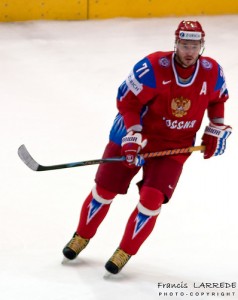With the Kontinental Hockey League season now in full swing, now is as good a time as any to revisit the discussions surrounding the Russian-based professional league. While there has been much debate as to how severe of a threat the KHL is to the NHL, we’ll be looking at the overall impact the emergence of another professional league could have on the game of hockey.
Soccer As the Blue Print
When it comes to being a global game, soccer is the undisputed heavy-weight champion. While there are many reasons why soccer is “the world’s game,” including accessibility — nothing more is needed than a ball and a bit of open space — what is also a key catalyst in driving soccer’s popularity is the parity among its top leagues. While hockey has its top talent highly concentrated in one league based in the U.S. and Canada, soccer’s stars are dispersed throughout a number of leagues in countries such as the U.K., Spain, Italy, France and Germany. This means that more of the world is exposed to seeing the game played at its highest level. While much of the soccer world gets to see Lionel Messi play, outside of the Winter Olympic Games, most European hockey fans will never have an opportunity to watch Sidney Crosby.

If the KHL — although still a ways off — can establish itself as a bonafide contender to the NHL, it would help disperse the game’s talent. For the most part, European club hockey currently is reserved for has-beens, less-than-NHL-caliber talent and North American castoffs. Although the KHL has players talented enough to play in the NHL — such as the enigmatic Ilya Kovalchuk, Evgeny Kuznetsov, Alexander Radulov and Sergei Mozyakin — it still has yet to attract any elite non-Russian talent. It’ll be a telling sign when the first big-time North American player jumps ship and signs on with a KHL club.
Another great aspect of soccer on the club level is the UEFA Champions League, which locks the top teams together in competition. Imagine just as you can have Arsenal squaring off against Real Madrid or Bayern Munich battling Inter Milan, you could watch Original Six team Chicago Blackhawks square off against storied Finnish franchise Jokerit (slated to join the KHL in 2014) or have the made-for-TV matchup where Ilya Kovalchuk and CSKA Moscow come stateside to lock horns with the New Jersey Devils. Although there is currently the European Trophy, it is far from being on the same level as the Champions League.
What hockey needs is an international club tournament featuring the world’s best teams. Who wouldn’t want to see the Stanley Cup champion face the winner of the Gagarin Cup? Much like the Champions League, the two teams would play a home-and-home series where the team with the better aggregate score would be deemed the winner. However, there would be the added element of playing on two different style rinks. It’d be compelling to see a North American team cross the pond and play on a 200×100 foot ice surface and then see a European team come over and play on a 200×85 rink.
Competition is Healthy
Right now, the NHL is king of the hockey world. But what would help accelerate the growth of the game would be some healthy competition. For the last several years the NBA, NFL and NHL has tossed around the idea of international expansion. Outside a few games being played abroad, no league has made any headway. While the NHL has been spending their days contemplating its next move, the KHL is quickly growing its reach. In addition to its presence in Russia, by 2014, the KHL will also have teams in Croatia, Belarus, Ukraine, Latvia, Kazakhstan, Slovakia, Czech Republic and Finland en route to a planned Pan-European league that could one day consist of 64 teams in 22 countries.

As the KHL continues to expand, it should only get stronger. This could be just the push the league needs to finally move toward European expansion. There’s not a doubt NHL teams could thrive in places like Stockholm and Helsinki. Having two major leagues that reached across the hockey world would go a long way in growing the game.
Increased competition from the KHL would also go a long way in ensuring labor stability and keeping players’ salary at a consistent level. If there would have been a threat of players not just going over to Europe temporarily, but for good, you can bet NHL owners would have never locked out the players last year. Whenever the person on the other side of the table has other options, it makes it far more difficult to negotiate by playing hard ball.
The only fear here is how fiscally responsible are KHL clubs? It’s not out of the realm of possibility for some of these rich Russian owners to price themselves out of existence. Steven Lee Myers gives an interesting perspective on the KHL in his New York Times article. “The league’s greatest challenge is a business model still shaped by a Soviet legacy and an uneven transition to a market economy,” write Myers. “The teams rely on the financing from owners or sponsors, which include Russia’s biggest state-run or -controlled corporations, whose stakes and spending are far from transparent.” However, such problem would only hurt other, smaller KHL teams. As long as there would be a few NHL-level KHL teams, it’d go a long way in changing the economic landscape of the NHL and reshaping the game of hockey.
While the KHL still may be several years away from being a true contender to the NHL, it’s still fun to contemplate a hockey world with two powerhouse leagues. Some may have a bit of xenophobia when it comes to the KHL, but all signs point to a more prosperous path for the game of hockey with a more competitive global playing field.